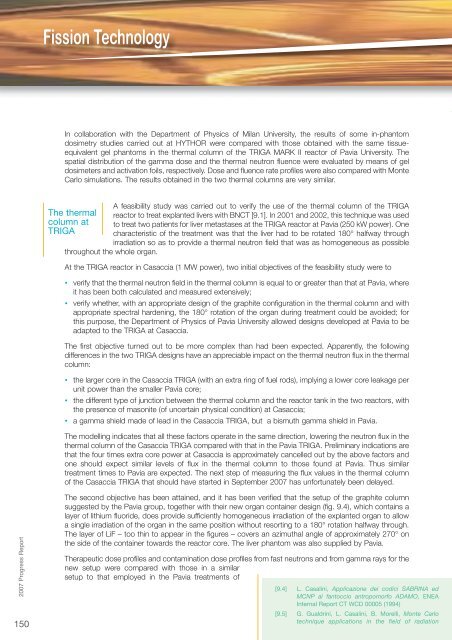Fusion Programme - ENEA - Fusione
Fusion Programme - ENEA - Fusione
Fusion Programme - ENEA - Fusione
- No tags were found...
Create successful ePaper yourself
Turn your PDF publications into a flip-book with our unique Google optimized e-Paper software.
Fission TechnologyIn collaboration with the Department of Physics of Milan University, the results of some in-phantomdosimetry studies carried out at HYTHOR were compared with those obtained with the same tissueequivalentgel phantoms in the thermal column of the TRIGA MARK II reactor of Pavia University. Thespatial distribution of the gamma dose and the thermal neutron fluence were evaluated by means of geldosimeters and activation foils, respectively. Dose and fluence rate profiles were also compared with MonteCarlo simulations. The results obtained in the two thermal columns are very similar.A feasibility study was carried out to verify the use of the thermal column of the TRIGAThe thermal reactor to treat explanted livers with BNCT [9.1]. In 2001 and 2002, this technique was usedcolumn at to treat two patients for liver metastases at the TRIGA reactor at Pavia (250 kW power). OneTRIGAcharacteristic of the treatment was that the liver had to be rotated 180° halfway throughirradiation so as to provide a thermal neutron field that was as homogeneous as possiblethroughout the whole organ.At the TRIGA reactor in Casaccia (1 MW power), two initial objectives of the feasibility study were to• verify that the thermal neutron field in the thermal column is equal to or greater than that at Pavia, whereit has been both calculated and measured extensively;• verify whether, with an appropriate design of the graphite configuration in the thermal column and withappropriate spectral hardening, the 180° rotation of the organ during treatment could be avoided; forthis purpose, the Department of Physics of Pavia University allowed designs developed at Pavia to beadapted to the TRIGA at Casaccia.The first objective turned out to be more complex than had been expected. Apparently, the followingdifferences in the two TRIGA designs have an appreciable impact on the thermal neutron flux in the thermalcolumn:• the larger core in the Casaccia TRIGA (with an extra ring of fuel rods), implying a lower core leakage perunit power than the smaller Pavia core;• the different type of junction between the thermal column and the reactor tank in the two reactors, withthe presence of masonite (of uncertain physical condition) at Casaccia;• a gamma shield made of lead in the Casaccia TRIGA, but a bismuth gamma shield in Pavia.The modelling indicates that all these factors operate in the same direction, lowering the neutron flux in thethermal column of the Casaccia TRIGA compared with that in the Pavia TRIGA. Preliminary indications arethat the four times extra core power at Casaccia is approximately cancelled out by the above factors andone should expect similar levels of flux in the thermal column to those found at Pavia. Thus similartreatment times to Pavia are expected. The next step of measuring the flux values in the thermal columnof the Casaccia TRIGA that should have started in September 2007 has unfortunately been delayed.2007 Progress Report150The second objective has been attained, and it has been verified that the setup of the graphite columnsuggested by the Pavia group, together with their new organ container design (fig. 9.4), which contains alayer of lithium fluoride, does provide sufficiently homogeneous irradiation of the explanted organ to allowa single irradiation of the organ in the same position without resorting to a 180° rotation halfway through.The layer of LiF – too thin to appear in the figures – covers an azimuthal angle of approximately 270° onthe side of the container towards the reactor core. The liver phantom was also supplied by Pavia.Therapeutic dose profiles and contamination dose profiles from fast neutrons and from gamma rays for thenew setup were compared with those in a similarsetup to that employed in the Pavia treatments of[9.4] L. Casalini, Applicazione dei codici SABRINA edMCNP al fantoccio antropomorfo ADAMO, <strong>ENEA</strong>Internal Report CT WCD 00005 (1994)[9.5] G. Gualdrini, L. Casalini, B. Morelli, Monte Carlotechnique applications in the field of radiation













